Skylab: America’s First Space Station

Skylab isn’t necessarily the first thing people think of when the subject of NASA and America’s space effort comes up. The Mercury Project, the Apollo moon missions, the Space Shuttle and the International Space Station are more likely to be mentioned. However, Skylab was America’s first space station, an underdog built from spare parts left over from the Apollo project that went on to set endurance records and make valuable contributions to solar and life sciences.
The Story of Skylab
On The Drawing Board
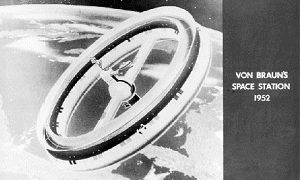
Space stations were not a new concept. Science fiction writers often included them in their stories and real proposals dated back to at least 1923, when rocket pioneer Hermann Oberth wrote The Rocket into Interplanetary Space. Rocket engineer Doctor Wernher von Braun, the man who had led the Huntsville team behind the Atlas and Saturn rockets for America’s early space program, popularized the idea when he helped Disney create a series on ideas for space exploration. This series included one early plan for going to the moon, in which the space station could be used as a refueling station. He also made sketches of a proposed “wheel” that could hold up to 80 crewmen and be used for scientific experiments.
The refueling station never materialized due to real world events that included Congress slashing NASA’s budget. In the interests of saving time, the infrastructure which would have been needed was never built. Instead, NASA officials decided to use Lunar-Orbit Rendezvous rather than the Earth Orbit Rendezvous that Doctor von Braun favored. While it certainly had its effect on NASA’s long term efforts, it also met the short-term goal of reaching the Moon by the end of the 1960s.
Initially, the space station that became Skylab would have been part of something much larger. A space station known as Project Olympus was on the drawing board. Project Olympus would have held up to 24 crew members and remained in orbit up to five years. The Apollo Applications Program was meant to make use of existing Apollo technology for long-term scientific missions and preparation for a possible Martian mission. Both were whittled away due to budget cuts and the fact that the space station was very low priority at the time.
A Few Early Ideas
Early on, producing artificial gravity on the space station was a popular idea. It could theoretically be done by spinning the space station, providing centrifugal force that would pull objects toward the edges as if they were in gravity. George Mueller was one of the few people who were against it and, to prove his point, he invited Robert Gilruth, Wernher von Braun and Sam Phillips to experience the idea for themselves. The Naval Aerospace Medical Institute in Pensacola, Florida, had a Slow Rotation Room meant to study the concept. The centrifugal force became uncomfortable over long periods of time and it was enough to convince the supporters of artificial gravity that it might not be such a good idea.
The Apollo Telescope Mount (ATM) was one idea that hung on even as the Apollo Applications Program got whittled away. It stemmed from a conversation Mueller had with someone from the Mount Wilson Observatory in which the benefits of putting a similar telescope in orbit was mentioned. The original idea called for the telescope to function as part of an independent spacecraft, perhaps integrating it into the Apollo Service Module or Lunar Module, but that was overruled by people who thought it would be too risky for the astronauts involved. The decision to go with a dry workshop allowed the ATM to be integrated with the Skylab.
One old disagreement cropped up while discussing the human element of Skylab. A human factors expert named Raymond Loewry wanted to include a window, which did not go over well with engineers who thought it would be too difficult to add. This meant a repeat of the argument which the Mercury astronauts had gone through with the same engineers. The Mercury astronauts were all pilots and argued that a window would make an invaluable addition to the spacecraft. They were proven correct during one Mercury mission in which the attitude control system malfunctioned and the astronaut had to make a manual reentry. Wernher von Braun was also a supporter of the window and, during one meeting, got into a heated exchange with Robert Gilruth over it until Mueller called a halt to it. Skylab got its window and Skylab 2 Science Pilot Joe Kerwin summed it up neatly: “Nothing beat looking out the window.”
The Competition
Salyut and the Manned Orbiting Laboratory
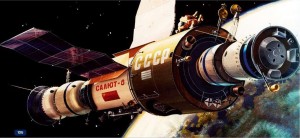
The people at NASA were not the only ones to consider a space station. The Russians’ first attempt at a viable space station was known as Salyut, a 43-foot-long spacecraft with a diameter of 13 feet at its widest point. It was designed for a crew of three cosmonauts. It was sent up on April 19th, 1971 and a crew of three men were crammed into a Soyuz without spacesuits. The first attempt to dock failed and they were forced to come home. A second crew went up and spent 23 days on the Salyut. They returned home in what looked like a good reentry but were found dead in their seats. There was some concern on the American side that the long duration of their mission had caused their deaths. However, in a rare moment of honesty for the time, the Russians revealed that an oxygen leak had killed the crew. The Russians temporarily suspended their space program and deorbited Salyut, clearing the way for Skylab to become the first space station to be manned by multiple crews.
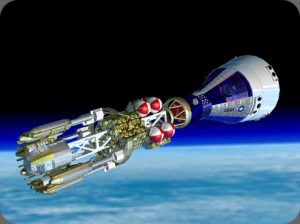
The Air Force was NASA’s main competitor on the American side. Their proposed space station was known as the Manned Orbiting Laboratory, meant mostly for military purposes. It would have been supplied by a series of spacecraft known as Blue Gemini, based on technology developed by NASA. The Air Force even had its own cadre of astronauts. Congress had originally encouraged NASA to support the Manned Orbiting Laboratory, but dropped the matter when NASA pointed out that doing so would only add to the costs. When the Manned Orbiting Laboratory was canceled, the Air Force astronauts were wrapped up into the NASA program.
Neat; where can I find out more about Salyut and Blue Gemini?
Good question. A lot of the Manned Orbiting Laboratory material was still classified last I heard, but there’s plenty of material on Salyut available if you’re curious. Check out the book below as an example.
Inside Of A Rocket Stage
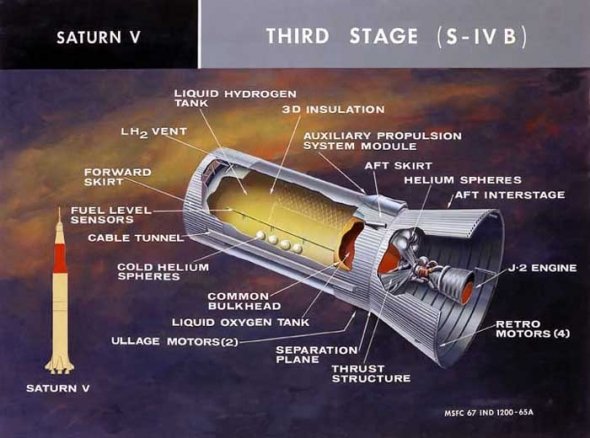
The Saturn V rockets used for the Apollo moon missions had three stages. The S-IC stage had five powerful engines that provided 7.5 million pounds of thrust. It was good for getting a spacecraft off the launchpad and well on its way to the edges of space. The S-II engine would take over when the S-IC stage was spent and take the spacecraft up to 185 kilometers in altitude. The S-IVB stage was used to get the Apollo into orbit and also send it on a course for the Moon. The manufacturers of the S-IVB stage, Douglas Aircraft, suggested modifying this stage as a space station.
There were two schools of thought on how to get a converted rocket stage into orbit and make it habitable. The chiefs of the Manned Space Center (MSC) favored a wet workshop, in which the S-IVB stage would be launched filled with fuel like normal, and that fuel would then be used to help boost Skylab into orbit. A crew of astronauts could then convert the spent stage into a habitat that they could live and work in.
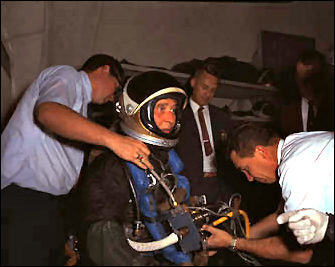
The people of Huntsville, Alabama’s Marshall Space Flight Center (MSFC) favored a dry workshop. The first two stages of the Saturn would be used to launch Skylab and the astronauts could simply dock and move in. The MSFC people argued that it would be too difficult for astronauts to perform the tasks required in the wet workshop plan. So, to settle the matter, MSFC director Doctor Wernher von Braun invited MSC associate administrator George Mueller to visit Huntsville and try performing the tasks that would be required in the wet workshop plan in a water tank he had installed on the Huntsville premises. He had actually built the tank during the Gemini program, when the difficulty of EVA and the need for better training became an issue, and could have gotten in hot water for an unauthorized expenditure. It turned out to be a good idea and von Braun had a mock-up of a “wet workshop” Skylab placed into the tank.
George Mueller got suited up in a training spacesuit and tried using a screwdriver in the tank. The effort sent him spinning in a way similar to what an astronaut in orbit might have experienced if he forgot to hold on to something. The difficulty of the task convinced him that the dry workshop would be better and Mueller took on the task of convincing MSC director Robert Gilruth.

The crew would use an Apollo Command Module to dock with Skylab’s Multiple Docking Adapter (MDA). The MDA would have allowed up to two command modules to be docked at any given time. The MDA also included the Apollo Telescope Mount attached to the main structure by the truss. It was powered by four solar panels and contained instruments for solar observations. The interior was designed as an experiment. Theoretically, in weightless conditions, it wouldn’t matter where the interior components were placed since everything was “falling” at the same rate. You could put furniture on surfaces that would normally be considered the ceiling or a wall.
While transferring from the command module into Skylab and moving from the MDA, the crew would then reach the Airlock Module. This included a large airlock that was based on Gemini technology and the crew could use for EVA. Its positioning was convenient when the crew of Skylab 2 had to make repairs to a solar panel. The Airlock Module was designed so that only this part of Skylab would be depressurized during EVA activity. There was some concern that the astronauts would not be able to repressurize the Airlock Module after a spacewalk, in which case the mission would be aborted early and the crew would return to Earth.
On the far side of Skylab was the Orbital Workshop. This was designed to be the main workplace of the astronauts and was designed for men used to orienting in 1G. It had a straightforward “up and down” layout with furniture on the floor, etc. It featured two “floors” and the lower “floor” was divided into two rooms. Initially, there was a fireman’s pole in the middle of the orbital workshop due to concerns that an astronaut could get stranded in the middle of the workshop. The astronauts quickly discovered that this would never be a problem. Even if an astronaut somehow lost his momentum, air currents would eventually push him to a wall. The pole was never extensively used. The air currents also had the side effect of turning part of the “ceiling” into a lost and found area where items that had gone missing could usually be found.
The crew’s living area was at the “far end” of the Orbital Workshop on the bottom floor. This included three sleeping compartments for the crew, their bathroom and kitchen areas, and an innovative shower. The crews would find the shower to be a lot of work. It was the problem of containing liquids again. A curtain helped but the crew had to mop up the excess water after each use. The dining and meeting area came to be known as “the wardroom.”
The Skylab Crews
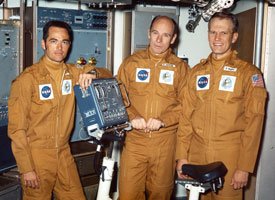
The SMEAT Crew
Karol Bobko, Bob Crippen and William Thornton crewed the Skylab Medical Experiments Altitude Test (SMEAT), a 56-day ground-based simulation of experiments scheduled to fly on Skylab. Not the most exciting job in the world for an astronaut, but it helped NASA refine its approach.

The Skylab 2 Crew
“We Fix Anything!” Commander Charles “Pete” Conrad, Pilot Joseph Kerwin and Command Module Pilot Paul Weitz crewed the Skylab 2 mission, which lasted for 28 days and featured the first repair of a spacecraft while in orbit.
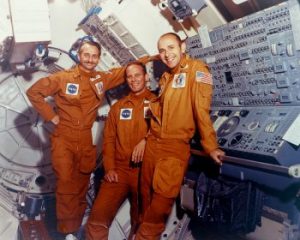
The Skylab 3 Crew
Commander Alan Bean, Pilot Jack Lousma and Science Pilot Owen Garriott crewed the Skylab 3 mission, which featured a mission duration of a little over 59 days and the first possibility of sending a rescue mission into space.
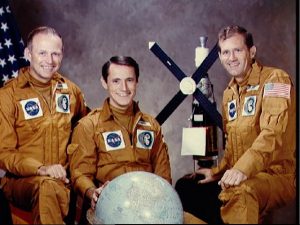
The Skylab 4 Crew
Commander Gerald Carr, Pilot William Pogue and Science Pilot Edward Gibson crewed Skylab 4, setting a mission duration record of 84 days and featuring a then-record spacewalk of 7 hours and 1 minute.
SMEAT
“Skylab Medical Experiments Altitude Test”
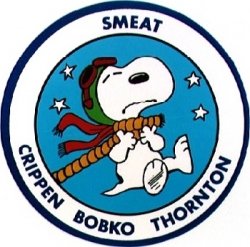
Skylab was such a low priority with NASA that it kept getting shoved back whenever there was a change in the schedule. The staffers and engineers working on Skylab began to joke about it because, for a while, it seemed like there was a permanent hold at T minus one year. However, it did give them time to fine-tune things. An astronaut named William Thornton was a former Air Force flight surgeon and inventor who often helped them test equipment that the astronauts would be using. If there was a way he could break equipment or otherwise force a redesign, he found it. His struggles with an ergonomic bicycle began when he broke the shaft holding the pedals. They redesigned it so that wouldn’t happen again. Fluid containment was always an issue in zero G and Thornton got them to redesign one collection device when they underestimated the volume needed. It got to the point where Skylab engineers were calling him King Kong because if he couldn’t break it, it couldn’t be broken by ordinary human strength.
Bob Crippen and Karol Bobko had both been members of the Air Force astronaut corp before the Manned Orbiting Laboratory was canceled. Bobko first broached the subject of joining NASA’s astronaut corp. Crippen thought it was a crazy idea. Apollo 18, 19 and 20 had recently been canceled and it wasn’t likely that any of them would get a flight until the Space Shuttle program began. However, they asked anyway and were brought on board. Although there wasn’t much for the former MOL astronauts to do and they often felt like second-stringers, that didn’t mean they had to sit on their thumbs. Bobko passed the time with the Apollo simulators, which nobody else cared about since the Apollo material was considered obsolete by this point. When he and Crippen were asked to crew SMEAT along with William Thornton, they weren’t thrilled but at least they had a job to do.
The main goal of SMEAT was to prove out the medical experiments planned for Skylab and test the astronauts’ ability to live and work together for almost two months. It would also provide more testing of some of the equipment. Thornton was especially interested in the equipment tests. He had questioned the on-board diet designed for the Skylab program and saw it as a chance to provide more testing of the bicycle. A mock-up of the planned interior design was built. The SMEAT crew conducted a few shorter tests in which they ran through a typical day’s activity, and then they were sealed in for 56 days.
The matter of whether a crew of three could work and live together peacefully for two months turned out to be a non-issue. Bobko credited the fact that they had already been working together for several months and he and Crippen had worked together before on the Manned Orbiting Laboratory. They had already worked out their crew dynamic.
The diet turned out to be a more finicky matter. Scientists considered it an important part of biological tests on Skylab and put out extra effort to balance the on-board foods to the nutritional needs of the astronauts. It included frozen items like steak and ice cream that wouldn’t be possible on the shuttle and the crews also selected wine to bring on board. However, the wine became an issue when word of its inclusion leaked out to the press. The dietitians were forced to drop it and redesign the menu. The dietitians also did not count on William Thornton’s by-now-legendary ability to “break” a system. Thornton believed that they weren’t making allowances for individual metabolism. He exercised almost continuously on the ergonomic bike when he wasn’t working on tests, burning calories until his crewmates became alarmed by his weight loss. Chief Astronaut Deke Slayton also championed the astronauts, telling the medical staff that it was unreasonable to restrict every Skylab astronaut to the exact same diet. The doctors agreed to design individualized diets in which each astronaut would act as his own control.
Tests also led to redesigns in the lower body negative pressure device, a recalibration of a blood pressure measuring device, the correction of several problems in the metabolic analyzer unit, and redesigns in equipment meant to process and store blood samples.
Skylab 1 Documentary
Skylab 1
A Near Disaster

Technically, Skylab 1 was the actual launch of the Skylab workshop on May 14, 1973. The Skylab 2 crew was already in quarantine. Chief Astronaut Deke Slayton would comment that it was strange to see a Saturn rocket without a Command and Service Module on top. Sensors would register a brief jolt to the rocket during launch. This jolt was the micrometeorite shield deploying prematurely, knocking away part of the heat shield and damaging the solar array. The full impact of this didn’t sink in until Skylab was apparently safely in orbit. Other than a higher than expected temperature within Skylab, deployment seemed normal until the Solar Array System beams failed to extend fully. The solar array was supposed to provide 2/3 of the workshop’s power. Temperatures continued to spike, making it obvious that part of the heat shield that was supposed to protect Skylab from the sun’s intense heat was gone. The temperature would reach 52 degrees Celsius, making it uninhabitable to a crew and endangering some of the experiments unless something could be done to bring the temperatures down and repair the solar panels.
The flight controllers in Mission Control created a list of almost 50 malfunctions to be looked into. The crew had been due to launch the next day but that was scrapped. They flew back to Houston to see what they could do to help solve the problem. Efforts to save Skylab had already started by the time they arrived.
The famous inter-center rivalry between the Manned Space Center (MSC) and Marshall Space Flight Center (MSFC) evaporated during the next week and a half. Engineers and technicians frequently sidestepped proper protocol to get stuff done. They were borrowing vehicles without permission to move equipment without authorization. One Marshall engineer named Jack Kinzler came up with a model parasol made of parachute cloth attached to four fishing lines. He showed MSC director Robert Gilruth, who gave his okay to build a working model. Unfortunately, a demonstration for NASA’s upper management failed and they decided to go with an alternative solution, a frame designed and built by a team led by Max Faget. So, Kinzler went to help Faget with his idea and Faget gave him a grin.
“Isn’t this fun?”
Kinzler had to agree. It was fun, in a high-pressure sort of way. Somebody chartered a Learjet to use for moving people and materials between Houston and Marshall. An ad-hoc clearinghouse called “Action Central” expedited the use of resources. People were staying at the MSC headquarters for long, stressful hours and often days at a time to find solutions and some of them suffered for it. One technician suffered a physical collapse from exhaustion and another broke down when he accidentally damaged a valuable piece of equipment. In the meantime, Mission Control was keeping an eye on an overheating Skylab and worrying. Ten days later, engineers and technicians had rigged an improvised replacement for the missing heat shield and procedures for making repairs to Skylab.
Skylab 2 Documentary
Skylab 2
“We Fix Anything”
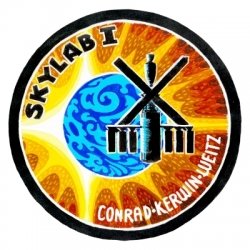 Conrad, Kerwin and Weitz finally got their day on May 25, 1973. Conrad came up with a way to boost Mission Control’s spirits. “Liftoff and the clock is running. … And Houston, Skylab 2, We Fix Anything, got a pitch and a roll program.”
Conrad, Kerwin and Weitz finally got their day on May 25, 1973. Conrad came up with a way to boost Mission Control’s spirits. “Liftoff and the clock is running. … And Houston, Skylab 2, We Fix Anything, got a pitch and a roll program.”
It would be a busy day for them. This was Weitz’s first mission and he worried about a seemingly sharp drop in thrust. This was a perfectly normal event known as the Propellant Utilization Shift. Conrad had been through this before and told him, “Cool it, rookie.” Eight hours later, they rendezvoused with a Skylab that was already showing the effects of exposure to intense heat. The area where the heat shield used to be, covered with a normally gold-colored Mylar, was turning brown. Flying around the space station, they discovered that one of the solar wings meant to provide power to the main workshop was missing. A fragment of the micrometeoroid shield had attached itself to the other wing and was holding it close to the body.
Conrad tentatively docked to Skylab but didn’t retract the drogue. If repairs proved impossible, they would have no choice but to abandon Skylab and the soft dock would save the effort of dismantling and resetting the docking mechanism. The crew took a break for a meal and to discuss options with Houston. They decided to try an EVA to free the stuck solar panel. Conrad took the command module around to the solar panel array. They depressurized the Command Module and Weitz performed a simple “stand up” EVA with Kerwin holding on to his legs to insure that he didn’t drift completely out. Weitz wielded a tool that looked like a shepherd’s crook. He hooked the stuck panel and pulled. The panel didn’t move. Instead, his effort pulled the command module toward the OWS. He was even beginning to move the giant Skylab. Conrad struggled to maintain their position. Finally, they gave it up and Weitz came back inside.
Conrad returned to the docking port. The first three attempts to dock failed, so they went to a previously untried docking method that required another EVA. Kerwin went outside and modified the docking probe. Then, Weitz did some rewiring in one of the equipment bays to remove the electrical interlock that prevented the main latches from actuating unless the capture latches were secure. Conrad tried docking again. The main latches engaged with an explosive sound that Kerwin compared to a machine gun firing. It was a big relief to both the crew and the people on the ground. This meant all their effort hadn’t been wasted and they could stay. The crew equalized the pressure between Skylab and the command module before calling it a night.
Their morning activities would determine whether they would be staying for the entire mission duration. The extreme heat inside Skylab could have caused toxic chemicals to be released into the atmosphere. Toxicologist Elliot Harris had led efforts on the ground to adapt an air sampling system to test Skylab’s air before the crew could enter. Activated-charcoal filter masks were also provided for the crew. They opened the hatch and removed the docking probe. Then, Paul Weitz used a sampling tube to get samples of air to test for tourine and carbon monoxide. Both tests came up negative and the crew opened up the Multiple Docking Adapter.
The trouble Conrad had gone through with docking led to one new concern for the commander: “Now that we’re docked, I’m not sure how to get undocked.” He inspected the docking probe and drogue and reported that one of the three capture latches was stuck closed. He had also managed to scrape the drogue during one of the docking attempts. Houston told him that they would study the problem and he put the probe in a secure place until they had an answer.
Although the interior of Skylab wasn’t as hot as they had feared, Conrad reported to Houston that it felt like desert heat, about 90 or 100 degrees Fahrenheit. They had to be careful with handling objects. At one point, Conrad commented that a water tank was “hotter than a two-dollar pistol.” They would also find that the heat had damaged several tubes of toothpaste and hand cream beyond any hope of using them. Conrad and Weitz retrieved the parasol from the command module to the Scientific Airlock that would give them access to the Apollo Telescope Mount. This was the side of Skylab that was almost continuously exposed to the sun and some of the experiments had gotten baked in the heat.
They created an airtight seal by sliding one end of the parasol’s container into the airlock. They cranked open the outer door of the airlock to expose it to vacuum. After a brief break to cool off, they inserted a series of seven rods into the free end of the container and pushed the parasol out into space. Engineers had created an improvised frame of four fishing poles that telescoped open until the parasol locked into space. Conrad reported that two of the rods hadn’t deployed properly, so they brought it back in for an inspection. They succeeded in getting it to deploy correctly on the second try.
With this success, Skylab began to cool off and Houston estimated that it would be back under 100 degrees by morning. At 9:40 pm Houston time, Houston made a stab at adjusting Skylab’s attitude so that the Apollo Telescope Mount was pointed at the sun. At 11:15, Kerwin noticed that they had missed the mark:
Kerwin (to Houston): We’re not in solar inertial [attitude], you know.
Houston: Roger. We assumed that we should be close to solar inertial attitude. We’re not solar inertial mode; we’ll be working that ourselves.
Kerwin: Well, you’re not even very close. Do you know where to go?
Houston: Probably not.
The crew ended up taking over the attempt to get Skylab into solar inertial attitude. Kerwin used the controls at the ATM to make minute adjustments to their attitude while Conrad and Weitz looked out a window and made estimates about how close they were. Finally, Kerwin had the computer finish the job and it successfully pointed the ATM at the sun. In case Skylab 2 or a future crew had to perform a similar maneuver, the crew found a spot where sunlight shone through a window and created a light patch on an opposite wall and marked it with duct tape.
The “We Fix Anything” crew was making good progress and, on Day 4 of their mission, they were able to begin a few of the medical experiments. Joe Kerwin took blood samples to process and freeze until their return to Earth and they began working with the lower body negative pressure experiment and Thornton’s dearly-hated ergonomic bicycle.
Mission Day 11 started off with an Earth Resources pass, meant to take pictures of Earth’s surface. It seemed to go well right up to the end, when Conrad told Weitz, “Close the S190 window cover.” It was already closed, which meant that they hadn’t gotten any pictures of Earth at all. This was the equivalent of forgetting to remove the cover of a camera lens and the result was a lot of blank pictures. This led to the creation of a new checklist that was taped near the Earth Resources panel.
On a more positive note, the crew solved the problem of how to ride a bicycle in outer space. During Apollo, an irregular heartbeat had been recorded in at least one of the Moonwalkers and the NASA medical staff wanted to make certain using the ergonomer was safe. Conrad’s solution was to stow the restraint harness in a stowage locker and let their heads float up to a headrest made up of a couple of towels duct-taped to the ceiling. He convinced the medical staff that his solution allowed for free exercise and it also had the side effect of clearing him to participate in the spacewalk two days later.
In the meantime, backup crew member Rusty Schweickart was leading efforts to loosen the stuck solar panel. Skylab would be stuck on low-power mode until the Solar Array System began producing power. It made for some minor annoyances when the crew forgot to turn things off or couldn’t use a particular piece of equipment and, on Day 6, they were forced to turn off the ATM’s Experiment Pointing Control system after some batteries went down. Prying it loose would mean another spacewalk.
The EVA
June 7, 1973
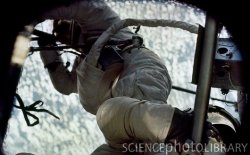
On the day before the spacewalk, Rusty Schweickart reviewed the procedures with the crew. If things went according to plan, Conrad would exit Skylab through the airlock’s EVA hatch, located in the middle of Skylab. He and Kerwin would then connect five aluminum poles to form a 25-foot pole. At one end of this pole was a limb lopper commonly used by telephone companies, which the crew called the “cutter.” The cutter was operated by two long ropes, one to open it and the other to close it. Kerwin spent a little time in his space suit, practicing with the cutter until he felt comfortable with it.
Once the pole was ready, Kerwin would emerge from the airlock, take control of the pole and proceed with Conrad to the A-frame. He would then maneuver the cutter into place over the strap restraining the solar panel and close the jaws. The cutter wouldn’t cut the strap just yet. Kerwin was to tie off the rope on a nearby strut. Each crew member would take one end of a rope called the beam erection tether (BET), which had two hooks on its end. Conrad was to move down the pole and fasten the hooks into ventilation openings below the SAS’s hinge. Kerwin’s end of the BET would then be tied securely to a beam, and then he would use the cutter to sever the strap.
Both crewmen would try to wiggle between the BET and the workshop and stand up, lifting the BET with them. Engineers hoped that this would produce enough pounds of force to break the offending hinge and deploy the solar panel. Conrad commented that if that last part went wrong, the crew ran the risk of getting “swatted like by a fly swatter.” Schweickart was confident that they could do it. “We’ve done it a lot, Pete, and it’s kind of fun. You’ll enjoy watching it come up. … Just for safety reasons, it’s a good idea, when you feel something break, to just stand back and let it go.”
The crew wasn’t quite so confident. Kerwin figured they had about a 50-50 chance of actually accomplishing their goal and Conrad remembered that there had been quite a bit of difficulty with EVA during the Gemini program. Conrad vetoed the idea of bringing along a TV camera on the grounds that it would only give them one more thing to keep track of. The issue of conserving power again came into play. Houston planned to have the Skylab crew turn off nonessentials and Conrad grouched about not being able to use the food heater for the next day’s lunch.
On the day of the spacewalk, Weitz made certain they had everything they needed and then retreated to safety. The two spacewalkers checked the integrity of the suits and Conrad noticed a little ice on the screen when he reached for the valve that would decompress the airlock. It caused the airlock to take a little longer than expected to reach vacuum. Finally, Conrad opened the hatch and Kerwin began assembling the pole. Once they were both outside, they took a moment to admire the view:
Conrad: Look, there’s half a moon.
Kerwin: You can see the lights, you can see the moonlight on the clouds.
Conrad: Oh, I can see the cities, yes.
Kerwin: Horizon to horizon.
Houston: Hey, can you guys stop lollygagging for just a minute so we can get a word to Paul [Weitz]?
Weitz had suited up in case Conrad and Kerwin had trouble closing the hatch when they were done. He was having some difficulty with his cooling system and discussed options with Houston. In the meantime, Conrad and Kerwin were pulling out umbilicals that would keep them connected with Skylab and provide them with air.

Conrad and Kerwin worked their way back to the point they referred to as the “A-frame,” a place at the edge of the Fixed Airlock Shroud where they could hold on to struts attached to the Skylab body. Skylab hadn’t been equipped for an EVA that would have taken them out to the solar panel. Kerwin struggled with getting the cutter’s jaws around the strap. The problem was having to maneuver the other end of a twenty-five-foot pole into position while having to deal with Newtonian physics. Kerwin decided he might have better luck if he moved one end of a tether preventing the pole from drifting away so that it was attached to a ring on his space suit instead of an eye bolt on Skylab. A few minutes later, he had the cutter in position. With a yank on the rope that would close the clamp, he finally cut the strap holding the solar panel in place.
Conrad maneuvered toward Kerwin, carefully adjusting the umbilicals so that they wouldn’t get pinched and cut off their air supply. They wiggled under the BET and pushed upwards. Kerwin remembered feeling a “pop” as something came loose. The solar panel successfully deployed at a ninety-degree to the main Skylab body and the three panels were unfolding. Houston noticed almost right away: “We see SAS amps!”
Kerwin finished up the EVA by moving up to the ATM end of Skylab, inspecting the doors and replacing film in one of the cameras. The spacewalk had lasted a little less than four hours. Houston sent up some congratulations: “Everybody down here is shaking hands, and we wish we could reach up there and shake yours.” Houston also relayed up a congratulatory message from President Nixon, commending them for their efforts in making Skylab a success.
A Day Off
Routine On Skylab
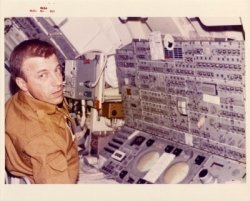
After the EVA, the Skylab crew began to settle into a routine. They improvised a fix for a coolant system that threatened to freeze, added the food heater and hot showers to their routine and discussed the possibility of a second EVA to put a better sunshade up. Houston decided to postpone that particular EVA until Skylab 3. The crew kept up with the scheduled activities and even found themselves with extra time on their hands. Conrad began inventing entertainment with a blue rubber ball. Kerwin, a physician, stayed busy with his medical kit. On Mission Day 22, over ice cream and strawberries at the end of the day, the crew complained, “It’s been Day 22 up here forever!” However, when Houston broached the possibility of staying up an extra week, Conrad responded like a typical Space Race-era pilot-astronaut. “You betcha, Houston, we’re ready!” The idea was scrapped, to the relief of the crew.

One main source of excitement was the sun, which the ATM was primarily designed to observe. Scientists on the ground hoped that the Skylab crews could add to their knowledge about solar activity. Catching a flare in action would be a huge plus and astronomers would send up information on possible areas to look. If one was detected early enough, the astronaut at the ATM controls could aim the ATM’s cameras right at the spot and set it to take high-speed photographs. This required quick reaction time and risked wasting film on false alarms. Astronomers didn’t know a lot about how flares started at that time.
Day 22 hadn’t been all bad despite their griping over sweets. Houston alerted the crew about a possible flare, the crew confirmed the readings and Paul Weitz aimed his camera right at the indicated area. Weitz got two minutes’ worth of photographs of the first solar flare observed from orbit. While other crews would build on their work, the entire Skylab 2 crew was, as Weitz put it, “proud as new daddies.”
Day 26 featured another EVA for repairs. Conrad and Weitz would clear away a bit of debris that was interfering with the view from the solar coronagraph and reset a relay that was preventing a battery from charging by whacking it with a hammer. Clearing away the debris was easy, just a matter of taking a brush to it. While resetting the relay, Conrad swung that hammer pretty hard:
Weitz: There it goes. Yes. Boy, is he hitting it! Holy cats!
Kerwin: Houston, EV-3. He hit it with the hammer. I turned the charger on, and I’m getting a lot of amps on the battery.
Houston: Okay. It worked. Thank you very much, gentlemen, you’ve done it again.
The two spacewalkers retrieved film from the cameras and came back inside. The EVA lasted only one hour and thirty-six minutes and the crew joked about doing Galileo’s hammer and feather thing like the Apollo 15 crew had done on the Moon.
They were nearing the end of their mission and were ready to come home. Conrad was pleased with the progress they had made considering that Skylab had been crippled when they arrived. He estimated that Skylab was now at 90% operational. On their final day, Day 28, Conrad told Houston, “It’s like a day-before-Christmas party up here.” And then the Trash Airlock jammed as the crew was disposing of a charcoal canister.
This could be bad. Without the Trash Airlock, garbage would pile up until it became a real nuisance. Houston scrambled to reproduce the problem to see if they could fix it. The first try failed, so the crew got firm with the stuck canister and finally managed to wrestle it free.
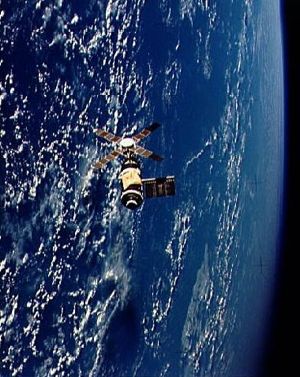
They got about five hours’ sleep before making final preparations to come home. They had to troubleshoot a problem with a refrigeration unit that could have delayed their undocking. The system’s radiator had frozen up and they solved the problem by pointing it at the sun. At 3:54, the radiator had thawed enough to give them a “Go” for undocking. Conrad made one last fly-around to give Skylab one last inspection and the crew got pictures of Skylab above an ocean background. The USS Ticonderoga recovered them shortly after splashdown.
Conrad was in the best shape due to his determination to walk away after splashdown. He had exercised so much that he developed a craving for the butter cookies included in Skylab’s snacks and arranged to have some waiting for him on the Ticonderoga. Doctor Ross was in charge of the on-board medical team and got the surprise of his life when President Nixon called to ask whether the Skylab crew could be cleared to visit the “Western White House” in San Clemente, California. It took some diplomacy for Ross to convince his counterparts back in Houston that it would be all right, and they agreed on the condition that the crew wear surgical masks.
Later on, Ross found out that Nixon had company in the form of Soviet leader Leonid Brezhnev. Members of the Ticonderoga‘s crew volunteered to make shadow boxes to hold gifts that had flown on Skylab and the crew rewarded them with mission patches. As the two world leaders approached, Conrad led his crew in a mini-rebellion by whipping off his face mask. Weitz and Kerwin followed suit and Ross began thinking up ways he could explain this to NASA’s medical staff. Conrad stepped up to the plate for him and took responsibility for the incident. As it turned out, there was no harm done and the meeting was a success. Doctor Kerwin summed it up in an articulate speech to the Congressional Committee on Space and Technology, in which he expressed his hope that space stations would become an integral part of the future. “We’ll be ready when you are.”
Skylab 3 – Tour of Skylab
Skylab 3 crew member Jack Lousma gives us a tour of Skylab.
Skylab 3

Despite the fact that the repair efforts by the Skylab 2 crew had been successful, engineers still worried about the parasol and the gyroscopes used to control attitude. They feared that an unmanned Skylab would deteriorate rapidly, so the launch of Skylab 3 was pushed up from August 17, 1973 to July 28. This was a first for an American space program used to delays and scrubbed launches.
Launch days often started early for the astronauts and the launchpad was lit up with search lights. Lousma thought it looked like a scene out of a new movie called 2001. He and Garriott were finally getting their first shot at a space mission after more than seven years of training. Commander Alan Bean was the veteran astronaut with the Apollo 12 lunar mission under his belt.
The science pilot was the last to board the spacecraft and Garriott got five minutes to himself while the launchpad crew helped Bean and Lousma strap into their couches. They were about to ride a gigantic firecracker that would accelerate from zero to five miles a second in ten minutes. He was certainly aware of the risks, but he was trained and ready and believed that he could handle himself if a problem developed during launch. He would always treasure those few introspective moments spent waiting just outside the craft.
Lousma certainly handled the pressure well. He fell asleep while waiting for launch. His main memory of launch was the moment they jettisoned the launch escape tower, which had been covering the windows, and he got his first clear view of space. Staging was quite an experience. They would suddenly go from multiple Gs down to a coast and an explosive would force the first stage off with a bang. Then the second stage would cut in, forcing them back against their seats again. When all three stages were spent, Lousma and Garriott enjoyed the experience of being weightless for the first time.
They were busy with rendezvous procedures when Lousma glanced out the window and spotted something that could have counted as an Unidentified Flying Object at the time. It had a conical shape and looked very familiar. “Owen, there goes one of our thrusters floating by the window!” Garriott looked and agreed. They were distracted by the checklists and didn’t think much of it at the time. Their eyes might be fooling them.
Bean reported a low-temperature master alarm on the thrusters. They figured it was a small propellant leak freezing inside one of their thrusters. The thruster-shaped thing they had seen turned out to be liquids from their own spacecraft that had gotten into the thruster and frozen. It was a lucky thing that the quad hadn’t exploded. Bean turned off the propellant to the affected quad, a bundle of four thrusters. They still had three good quads. It might mean adjusting the rendezvous with Skylab but it seemed like a minor matter.
Skylab came into view. With one quad down, the carefully prepared rendezvous plan went out the window. Bean had to fire the remaining three quads longer to compensate and also had to adjust his steering to allow for unwanted rotation. Lousma spent some time eyeballing the station to estimate their range rate, or the speed at which they were approaching Skylab, and then punched some figures on a 1970s-era HP calculator.
Bean got into an argument with Garriott over whether they were approaching too fast. If they couldn’t slow enough to match Skylab’s velocity, they ran the risk of hitting the space station or flying straight past it and having to rendezvous over the next few orbits. Garriott thought they were going too fast and abruptly ended the argument by getting out of his seat and heading for the lower equipment bay. Bean rethought his position, slowed some more and succeeded in matching their velocity right underneath Skylab.
The fly-around inspection of Skylab was somewhat tricky without the quad but Bean managed and docked with Skylab. However, that didn’t mean their adventures with those thrusters were over. On Day Six, Lousma called Bean over to the wardroom window to take a look at an unusual sight. He had been admiring an aurora over New Zealand when he noticed something that looked like a snowstorm. Sprays like that could only mean there was a leak somewhere. Bean decided that it had to be something on the command module. He and Lousma shot through the workshop, did some troubleshooting and confirmed that another quad was leaking. They cut off the propellant to that quad.
Now that two quads were down, their ride home was unreliable. Houston reassured them that they could continue with their mission. In the meantime, Houston swung into action to debate options. Could the crew come home safely with only two working quads? Were they going to have any more failures? If the crew couldn’t make it home, could they launch a rescue mission? While the crew did participate in the discussions, they weren’t particularly worried. If Houston couldn’t take immediate action, they had enough supplies to last for several months. It could have reminded some people of a movie called Marooned, featuring a crew unable to come home due to malfunctioning thrusters and a daring rescue mission.
Marooned
Features three astronauts who spent five months in a space station similar to Skylab. When thrusters fail to fire during their return home, NASA sends up a last-ditch rescue mission and gets some unexpected help from a surprising source.
Mystery Science Theater 3000 Tackles Marooned
Goofy premise for a TV show, but a guy and his robots lambasting nearly-forgotten old science fiction movies is always funny.
A Possible Rescue Mission

Like space stations, the idea of a possible rescue mission had been around for a while. Ideas had floated around for years and Apollo 13 had driven home the point that one might become necessary someday. George Mueller had spearheaded the idea of having ports for two Command Modules on Skylab if a rescue became necessary. A rescue ship could dock to the second port while the first remained in place to facilitate communications, and then the first could be jettisoned just before the crew left Skylab.
Apollo command modules were normally configured to carry three crewmen. Bean and Lousma had helped with efforts to reconfigure one to carry five people, with two couches located below the three main seats. It meant sacrificing some of the space that would have normally been used to carry equipment or experiments. The result was a priority list of items to bring back in the event of a rescue, consisting mostly of results from some of the medical experiments.
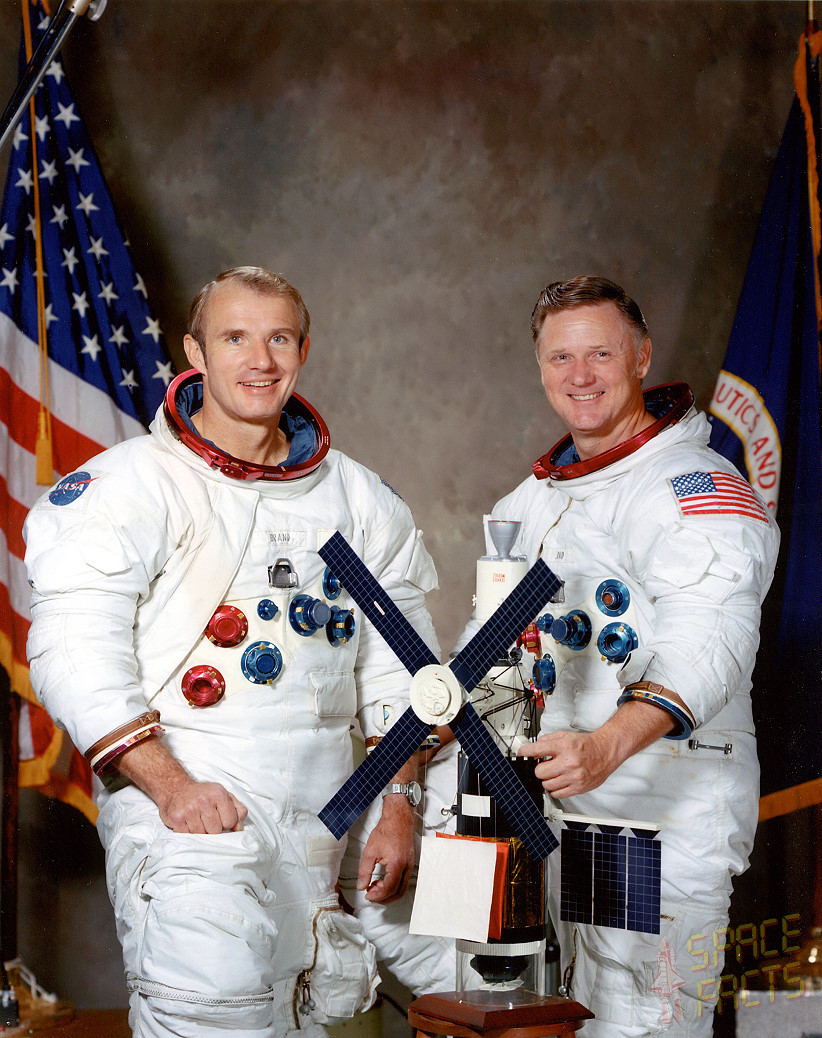
Vance Brand and Don Lind were two rookie astronauts who had been tapped as backup crew for the first two Skylab missions. Now, they were assigned to the potential rescue mission. Once again, the agency was pulling together with the goal of having the rescue mission ready in a month. The astronauts helped with tests for the modified command module genuinely believing that they were going to be the first rescue crew ever. That was pretty thrilling for two pilots who had never flown in space before.
There was a lot to be done in a month. Brand and Lind spent long days in the simulators, training and also confirming that the redesigned command module was ready to go. Most of it wasn’t going to be very different from a normal mission. They would launch, rendezvous and dock with Skylab, very similar to what they would have done if they were a normal crew.
The main difference was the two extra seats. Once they splashed down, the spacecraft could stabilize in a position that could be awkward for the extra astronauts. They would be hanging from a spot close to the ceiling. Brand and Lind helped to test the concept. While briefing the crew that would be “rescued” in this simulation, Lind told them, “You won’t be able to tell which way is down, so when I tell you to unstrap, be sure to hang on to something because you may feel like you’re falling straight up.” Of course, there’s always one in every bunch who will not listen and Bill Lenoir just rolled his eyes. When they had splashed down and Lenoir unbuckled, he forgot to hold on to something and fell into a bulkhead. He was not happy but couldn’t claim that he hadn’t been warned. Otherwise, the test was successful.
Near the end of the thirty days, most of the people involved were confident that it could be done. Management decided to focus on ways to get the Skylab 3 crew down on their own. The people at the Johnson Space Center developed alternative reentry procedures that would allow for the malfunctioning quads and possible future thruster malfunctions. Brand would remember the preparations for the rescue mission as a very satisfying experience, even though NASA decided to change modes and he was reassigned to the job of helping to determine whether the wounded Command and Service Module currently docked with Skylab could bring the crew home safely.
EVA #1
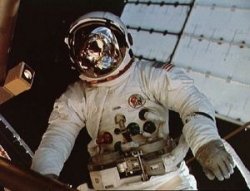
In the meantime, the Skylab 3 crew was settling in. Both Alan Bean and Owen Garriot began flight diaries. Garriott’s indicated some “stomach awareness” in his entry for Mission Day 4 (July 31, 1973). The space-sickness slowed them down for the first few days and, on Mission Day 3, Bean griped in his diary that the flight planners seemed to be in too much of a hurry. Scop-Dex did help but no one wanted to move around much. They talked it out with Mission Control, who agreed to delay an EVA scheduled for Day 4.
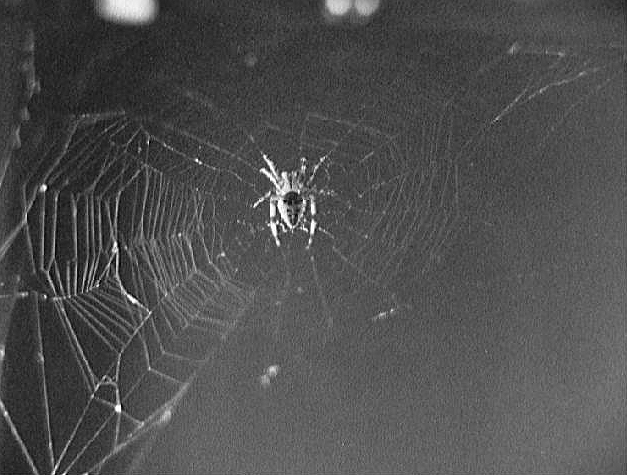
By Day 8, they were feeling well enough to tackle a normal schedule. On Day 9, they got in two good Earth Resources Experiment Package (EREP) passes. They also activated an experiment involving “Arabella” the spider. Arabella and her “sister,” Anita, were an experiment proposed by a high school student from Massachusetts, who wanted to learn about how spiders would react to weightlessness and especially how they would spin their webs. Garriott remarked that Arabella’s first webs were “very scruffy-looking,” but they improved in a matter of days. For all the good science that would happen on Skylab, the spiders got the most attention from the American public.
Day 10 began with Alan Bean writing in his diary. The first EVA was scheduled for this day and he woke early. He commented on how different sleeping in orbit was and thought of patenting some of the changes he had made to his bed. The plan on this EVA was to replace the ATM’s film and also deploy a Marshall Sail twin-pole sunshade to supplement the parasol that the Skylab 2 crew had put in place. The parasol was beginning to lose its effectiveness and the sunshade would help bring temperatures back down.
Retrieving the film from the ATM cameras went well. The area around the Apollo Telescope Mount was the only place on Skylab that was designed to support a spacewalk. To help the situation, Lousma had a set of foot restraints he could attach to Skylab to hold himself in place once he reached the tress structure. Garriott stayed put near the Airlock Module as he assembled the poles and extended them to Lousma. The gloves on his space suit made it difficult to remove the rods from the elastic straps holding them into place. He ended up securing the supporting frame with one foot and using both hands to wrench the rods from the elastic straps.
In the meantime, Lousma was setting up an adapter to hold the poles that would be inserted into two slots. There was some concern on the ground that the poles would react like two enormous fishing rods and whip around when they were moved. These rods were fifty-five feet long and thin. Lousma claimed that he could tell the difference but considered it a nonissue. The bigger concern was the fabric for the sunshade. It had been folded up and packed before the adhesive had time to set and the sunshade didn’t unfold all the way when he deployed it. He had to manually unfasten all the folds but missed a few. He got the sunshade into place using some long lanyards and the two poles flopped down to hold it into place. The sun did the rest of the job, baking the sunshade until the folds Lousma had missed came undone on their own. The result was a white streak on the sunshade that can be seen in some pictures of Skylab.
Lousma and Garriott did some searching for a coolant leak that would bother them until the end of the mission, and then called it a day. Their EVA had lasted six and a half hours.
Coronal Mass Ejection
 Over the few days following the EVA, Garriott got some productive time in with the ATM. He recorded solar flares on days 11 and 12, and then made history on Day 14 by capturing the first coronal mass ejection seen from space.
Over the few days following the EVA, Garriott got some productive time in with the ATM. He recorded solar flares on days 11 and 12, and then made history on Day 14 by capturing the first coronal mass ejection seen from space.
It was supposed to be a day off and nobody was manning the ATM. The ground alerted them about the start of a solar eruption and Garriott flew to the ATM in time to catch the ejection in progress. It grew to its peak of about three times the width of the sun in a matter of hours. Garriott calculated that it was moving at a speed of at least 500 kilometers per second. Earth-based scientists were excited by the discovery and, over the air-to-ground loop Mission Control set up for the astronauts to chat with their families, Garriott’s wife told him that his observations was all over the local news. Coronal mass ejections can wreak havoc with Earth’s systems if they are aimed in our direction and Skylab laid the groundwork for studying them.
Hitting Their Stride
Around Day 14, the crew began to feel like they were hitting their stride. Both Bean and Garriott noted in their diaries that they were feeling more efficient. Bean began asking Mission Control for more work, which seemed to annoy Garriott a little. At first, Mission Control refused to schedule more work for them and they invented entertainments for themselves. Bean got pretty good at zero-G acrobatics. The people on the ground invented Earth observation experiments, in which they would try to spot or identify something on Earth’s surface. It did lead to one embarrassing moment for Garriott when he failed to recognize his hometown. They also added some additional experiments they could do with the hardware already on Skylab.
On Day 16, the gyroscopes meant to control Skylab’s attitude fouled up and lost attitude control. Bean ignored procedure and used the TACS thrusters to solve the problem. He especially remembered that one because, the next day, Mission Control sent up a new procedure that essentially told them to do the same thing if nothing else worked. It was moderately annoying and, a few days and a couple of malfunctions later, he was tempted to make a joke about their schedule for troubleshooting glitches but decided Mission Control probably wouldn’t appreciate it.
A second EVA scheduled for Mission Day 28 would help fix the gyroscope problem. There were actually two sets of gyroscopes on Skylab. The large ones were called the Control Moment Gyroscopes and were used to move Skylab into new positions or hold it in place. The smaller ones were meant to monitor the station’s attitude and these ones were proving erratic. The EVA would install a cable and activate a new set of six gyros along with retrieving the film on the ATM. They called these gyros Skylab’s “six-pack.”
Bean spent a few days before the EVA deciding who to send outside. At first he debated whether it would be himself and Garriott or himself and Lousma, but then he decided that the best place for him to be was in the Command Module. Garriott and Lousma would go out together. Lousma was the strongest and also good at fixing things and Garriott would do a good job of backing him up. On Day 26, he informed Mission Control of his decision and they gave the okay.
EVA #2

Garriott did most of the actual work of installing the six-pack gyros inside Skylab, but activating them meant going EVA. Lousma had to disconnect the old cables by twisting them from their sockets, and then put in new ones. In microgravity, this meant accounting for Newtonian physics. Many of the early astronauts had practiced performing zero-G activities in a C-130 that could simulate weightlessness for several seconds at a time. If they tried to use a screwdriver, they risked sending themselves into a spin if they forgot to hold onto something. Lousma faced a nearly identical problem here. When Bean asked how things were going, he said that he was having some difficulties with a couple of connectors and just needed a chance to work on them. He solved it by finding a tight place to wedge himself into while he worked with the connections.
For all the difficulty, the EVAs were Lousma’s favorite part of Skylab. When he was near the ATM, he asked Bean to turn off the running lights. This was on the night side of Earth and he could not see a thing. It was certainly a unique experience to orbit the Earth at 17,500 miles per hour and be able to cling to his spacecraft with only one foot.
While retrieving the film from the ATM and passing them back to Lousma, Garriott found a moment to admire the view. Their orbit was taking them over South America and, if he had been holding a camera right then, he could have gotten some spectacular images of the snow-capped Andes Mountains framed by Skylab’s solar panels.
When the day was over, Bean noted in his diary, “Good EVA today – Everybody happy.” The only bummer was a TV camera that had overheated and quit on them. He blamed it on lack of insulation. The next day, they passed the world record for mission duration.
Life On Skylab
On Day 30, Skylab scored another first when a representative from NASA’s science community, Dr. Robert MacQueen, became the first Principal Investigator to speak directly to the crew. Normally, only the astronaut at the CapCom position talked directly to the crew and non-controllers didn’t get on the line at all. Garriott believed that being able to talk directly to the scientific community was useful for getting feedback on their work. Both he and Bean thought that perhaps NASA should downplay the spiders that were getting most of the attention from the American public. They thought the average taxpayer might be upset over their money being spent on orbiting arachnids.
Garriott hoped to mitigate this by filming several educational videos that he thought might be useful for students. He used some rod magnets to demonstrate microgravity. When he released them, they would oscillate in three dimensions rather than the one or two dimensions seen in magnets on Earth’s surface. If they were placed near each other, the oscillations would be reduced or canceled. Other video themes included “Gyroscopes in Space,” “Conservation Laws in Zero-G,” and “Fluids in Weightlessness” and were distributed to schools by the NASA centers.
They were certainly enjoying their work. On Day 33, they argued a little over who got to do the last ATM of the day. Garriott offered to do it but Lousma declined, saying that he wanted to find more Ellerman bombs. Bean told them both that the people on the ground had assigned him the last pass. Garriott was amused; Bean was already getting a reputation as a workaholic. He had to keep reminding himself not to multitask to avoid mistakes. The ATM moved too slowly for his taste and he often missed something because he was working on another project while waiting for the machine to catch up.
Garriott was the best at working the ATM and Bean decided simply to let him and Lousma handle it. It paid off when Garriott got a Class X flare, the largest possible, on Day 42. This and the fact that the sun was going through an unexpected upswing of sunspots was exciting for both the crew and scientists on the ground.
Garriott had his own disagreements with the doctors when they somehow lost several days’ worth of exercise data. Though he had been using the bike, the doctors accused him of slacking off and Bean and Lousma teased him about it. When the loss was discovered, Garriott let them know exactly what he thought of that. However, he was able to repay the ground for the mess-up with a prank he had planned before the mission. His only accomplices were the Capcom, Bob Crippen, and Garriott’s wife. On Day 46, Garriott alerted Crippen with a seemingly innocuous comment, “I’ll have something for you on the next pass, Bob.” Crippen took that as his cue to secretly review the planned script. Skylab passed into a gap in the ground network’s coverage and, when Houston regained contact, they got one of the most surprising moments in the American space program.
Mrs. Garriott: Gad, I don’t see how the boys manage to get rid of the feedback between these speakers. … Hello, Houston, how are you reading me down there? (Pause) Hello Houston, are you reading Skylab?
Crippen: Skylab, this is Houston. We heard you all right, but had difficulty recognizing your voice. Who do we have on the line up there?
Mrs. Garriott: Hello Houston. Roger. Well, I haven’t talked with you for a while. Isn’t that you down there, Bob? This is Helen, here in Skylab. The boys hadn’t had a good home cooked meal in so long, I thought I’d bring one up. Over.
Crippen: Roger, Skylab. Someone’s got to be pulling my leg, Helen. Where are you?
Mrs. Garriott: Right here in Skylab, Bob. Just a few orbits ago we were looking down on those forest fires in California. The smoke sure covers a lot of territory and, oh boy, the sunrises are just beautiful! Oh oh, See you later, Bob, I hear the boys coming up here and I’m not supposed to be on the radio.
It was a quarter century before Garriott admitted how he had pulled that one off. He had gotten Helen Garriott to record a few variations on that script and then taken it with him to Skylab. Crippen was a good enough actor to make it sound natural and then fake complete ignorance when questioned by other controllers. When Garriott finally told the story behind his joke at the 25th anniversary celebration in 1998, he commented that it was one of his favorite “gotchas” of the Apollo-Skylab era.
EVA #3
Mission Day 43
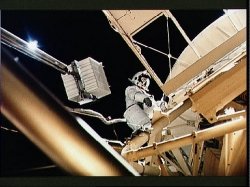
Alan Bean faced a difficult decision on who would make the final EVA with him. Both Garriott and Lousma had already done two EVAs. He talked it out with Lousma and decided on Garriott, whom he thought might not get another space flight.
The EVA would last less than three hours, with the goals of retrieving the final set of film canisters from the ATM and also a parasol sample to be tested back on Earth. Bean remembered the egress through the airlock as being definitely different from emerging from the Lunar Module during his Apollo 12 mission. On the moon, there had been the reassuring presence of gravity, even if it only 1/6 the force it would have been on Earth, and he came out backwards down a ladder. On Skylab, he came out facing forward and there was a definite sense that he could fall endlessly into nothing. He later described the Skylab EVA as “much more like science fiction.”
Another highlight for him was a night-side pass with nothing to do. He had been working on the doors for the ATM when Houston informed him that they wanted to wait until daylight to test the doors. That gave him thirty-five minutes to observe the night side of Earth. Skylab was over the Mediterranean region when sunset came and he spotted a volcano named Mount Etna in Sicily. Over the Persian Gulf region, the fires from the oil rigs stood out in the dark. Just for fun, Bean did the first documented handstand during an EVA and later joked that he had set a record for height and speed during a handstand.
It was over too soon and they came back inside. By Day 51, they were beginning preparations to come home. During their last real “day off” on Skylab, they took Seconals and went to bed early. Garriott filmed a few more TV segments over the next couple of days that included some fun with paper airplanes. He commented that making them like one normally would on Earth simply caused them to do loops but adding some more folds in the nose helped. They also demonstrated how Bean could do push-ups with two men on his back, with Garriott hamming it up by pretending the stack was going to topple over. Bean thought that would be a funny add-on to movies about Skylab and later learned that their “stunts” had made it onto national television.
Return To Earth
Backup crew members Vance Brand and Don Lind had helped work out the procedures for returning to Earth with two crippled thruster quads. Brand was in the Mission Control room when the Skylab 3 mission came to an end and described the atmosphere as confident but not overconfident. Bean had scribbled notes on sheets of paper when they sent up the revised checklist. Garriott was going to read them off but found it impossible to read Bean’s handwriting. Bean took over the book and Garriott focused on resetting switches to compensate for the reduced thruster power.
Reentry in an Apollo Command Module meant that they were facing aft as they fell and Lousma remembered watching the fireball trailing after them. He described it as “like flying in a cone of flame.” This was caused by both the heat and the ionized gases from the heat shield. The Command Module splashed down and settled into a position that had them hanging upside down from their seats. In one G, this was somewhat uncomfortable and they were just as happy that their recovery ship New Orleans arrived promptly.
After almost two months in space, adjusting to life on Earth’s surface was a challenge. Garriott had trouble telling up from down in complete darkness for his first few days back on Earth. He meant to gripe to Bill Thornton about his mass measurement devices, which required constant calibration, but changed his mind when he saw Thornton with a smile and a big bottle of champagne. Bean noticed difficulties with his balance and didn’t want to stand up very much or even sit for long. Both Lousma and Bean noticed that they had developed habits on Skylab that would do no good on Earth. They both tried flying from one place to another the same way they would have in weightlessness and Lousma broke a bottle of shaving lotion when he tried to push it from one hand to the other and it fell in the sink.
NASA officials and scientists were very happy with the work that the Skylab 3 crew had turned in. Bean kept a newspaper article that called Skylab 3 a “Supercrew” as a souvenir. Skylab Program Office manager Kenneth Kleinknecht commented that they had accomplished 150% of their goals.
Launch of Skylab 4
16 November 1973
https://www.youtube.com/watch?v=udPYU4YqoPs
Skylab 4

Skylab 4 was tentatively scheduled to last 60 days with the possibility of extending it based on the condition of the crew and the status of consumables. For Jerry Carr and Bill Pogue, the initial assignment to Skylab had come off feeling like a consolation prize. They had been tentatively slated for Apollo 19, a lunar mission that never flew. Edward Gibson was added to round out the trio of rookie astronauts.
The runaway success of Skylab 3 led to trouble for Skylab 4. Scientists thought that they had simply failed to plan enough activities for the Skylab 3 crew and hoped to make up for it with this mission. Also of interest was the recently discovered Comet Kohoutek, which would be passing close enough to Earth to be visible from orbit. They hoped to use the ATM, designed for solar observations, to capture photographs.
Between the last-minute additions and the fact that the previous two crews had gotten priority in the simulators before their missions, traning posed a challenge. Science Pilot Ed Gibson was the astronaut corps’ leading expert on solar physics and specialized in solar observations with the ATM. Pilot William Pogue concentrated on most of the on-board experiments while Commander Gerald Carr focused on Skylab systems for navigation and guidance. With the addition of more Earth observations, they went to Ken Kleinknecht and got a promise that they could reserve forty hours of training time and bring in top experts from around the world. Their experts included oceanographers, earthquake-fault experts, meteorologists and ice formation experts who eagerly came out to help with training.
As they continued to add experiments, Carr recognized the potential problem and tried to head it off at the pass. He explained to project managers that there was no way they were going to be able to keep up the pace for three months. Tthe managers agreed and tried to back off a bit, but then caved to pressure from the scientists and added a lot more experiments at the last minute. After a delay of almost a week to repair cracks in the rocket booster, Skylab 4 launched on November 16, 1973.
Launching Humpty Dumpty

After the planned November 10th launch was scrubbed, the crew began referring to the rocket as “Humpty Dumpty,” a name that reached the media to the displeasure of the launchpad crew. The crew only heard about it at T-20 minutes, when the launchpad told them, “Good luck and Godspeed, from all the king’s horses and all the king’s men.”
The launch went off well if not very smoothly. When the engines took over, Gibson’s instincts insisted, “The basement just exploded!” He was partly correct. There was a controlled, explosive mixing of liquid oxygen and liquid hydrogen going on several stories beneath him. As the coast of Florida receded, he flipped a few switches to reconfigure the spacecraft for rendezvous with Skylab, not yet realizing that at least one Florida policeman was observing the launch. When he got back, a highway patrolman presented him with a ticket, telling Gibson that he had been clocked doing 17,682 in a 40.
Carr compared the launch to a train wreck in which they were accelerating instead of coming to a sudden stop: lots of vibration and noise and a couple of lurches during staging. When the escape tower jettisoned, taking the shroud with it, he was blinded for a moment. Part of Europe was visible through his window when he got his first good view of Earth and he thought, “Italy really is shaped like a boot.”
They docked with Skylab and everything about both spacecraft looked nominal. After Skylab 3’s initial difficulty with space sickness, mission planners had decided that the Skylab 4 crew would spend their first night in the command module. Even so, the crew wasn’t feeling all that great. Pogue was feeling really miserable and caved readily enough when the doctors ordered the crew to take Scop-Dex, a medication meant to treate space sickness. That surprised his crewmates since he had flown with the Thunderbirds and people called him “Old Iron Ears” for his ability to handle any maneuver in an airplane. It was proof that there was no predicting who might get space sick. Carr refused to take the medication on the grounds that he was the one who would have to drive if they had to undock for some reason and the command module could technically count as heavy machinery.
The crew contemplated not telling the ground about the space-sickness, but Pogue forgot to throw a switch that would have turned off the recorder. The recording got transmitted down to Houston and Alan Shepard got on the Capcom loop to talk to them about it. They agreed that it had been a dumb move. As with the first two crews, space sickness would slow them down for the first few days. Carr and Gibson felt almost normal after a few days, but Pogue continued to struggle and his crewmates tried swapping jobs around so he wouldn’t have to move around as much.
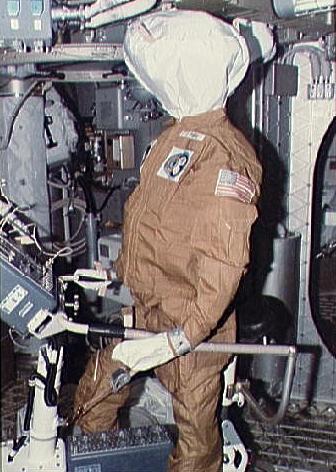
Finally, the time came to open the hatch. They drifted into Skylab and discovered that the space station was already occupied by three silent crew members. The Skylab 3 crew had left a surprise for them by stuffing three brown flight suits, attaching some stuffed paper bags for heads and leaving them on Skylab’s lower deck. The crew was very busy at first, so they couldn’t find the time to dismantle and put away the dummies at first. Gibson commented, “I felt them staring at me, inspecting everything I did, but not lifting a hand to help. Eerie.”
Pogue’s first impression of Skylab was that it was cold and bigger than he had expected. It was so big, in fact, that they actually managed to lose Gibson. He was in the Orbital Workshop behind one of the freezers, looking for some procedure manuals, when Carr and Pogue came down to look for him. After a cursory scan, they decided that he wasn’t there. Carr commented, “Hey, the Command Module’s still here. The hatch isn’t open. Guess he hasn’t left. So, then, where is he?” Houston was equally baffled, “How do you lose a crewman in a spacecraft?” Finally, Gibson floated back into view and they asked, “Where the heck have you been?”
EVA #1
Mission Day 7
 By Thanksgiving Day, Pogue was feeling well enough to participate in the first planned spacewalk with Ed Gibson. They spent six and a half hours outside, retrieving and installing ATM film, making repairs to the microwave antenna, deploying an experiment on the ATM truss, and taking pictures. Like most of the Skylabbers, Gibson remembered the EVAs as hard but enjoyable work. He had spent enough time in the water tank at Marshall to almost expect to see support divers when he went through the hatch. Instead of divers, there was an amazing view of a part of the space station with Earth as a backdrop. Views like this were definitely worth the hundreds of hours that astronauts spend training for each mission.
By Thanksgiving Day, Pogue was feeling well enough to participate in the first planned spacewalk with Ed Gibson. They spent six and a half hours outside, retrieving and installing ATM film, making repairs to the microwave antenna, deploying an experiment on the ATM truss, and taking pictures. Like most of the Skylabbers, Gibson remembered the EVAs as hard but enjoyable work. He had spent enough time in the water tank at Marshall to almost expect to see support divers when he went through the hatch. Instead of divers, there was an amazing view of a part of the space station with Earth as a backdrop. Views like this were definitely worth the hundreds of hours that astronauts spend training for each mission.
Getting to the antenna was made more complicated by the usual problem of lack of handholds on that part of Skylab. They had brought some portable foot restraints and spent part of their training troubleshooting the problem. Pogue used the restraints and held on to Gibson’s feet while he did the work on the antenna. It was tricky but effective. It took almost an hour to unscrew and remove the cover with the electronics box attached to the antenna and the effort bruised Gibson’s fingers. They had to remove several sheets of insulation made with shiny aluminized Mylar. Some of it floated away and Gibson commented that it looked like some flashing red lights following them. The result was rumors that Skylab had been followed by UFOs, which got fanned by the tabloids. Gibson thought that was silly. The EVA left them with one clear memory in the blur that was the early part of Skylab 4.
A Tight Schedule
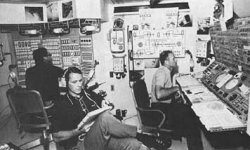
Over the first part of the mission, Carr’s prediction about the consequences of such a tight schedule began to prove accurate. The crew had been sucked into a daily routine that didn’t allow much time for either mistakes or leisure. If they tried to hurry, they would inevitably miss a step or throw the wrong switch and have to go back and do it again. They began to fall behind and messed up a few experiments because they were trying to race the clock. It was hard on crew morale and frustrating for the science teams on the ground when the crew had to report that an experiment hadn’t been done that day or had been fouled because the astronaut running the experiment was in too much of a hurry. It even cut into their sleep time.
The controllers on the ground tried to help by rescheduling things and it got to the point where the crew was trying to do makeup work for their first few “days off.” Finally, Carr called a halt to it and decided that they would just do their own thing on their next day off. Gibson did some work at the ATM and handled some simple experiments while Carr and Pogue made some Earth observations and photography. It helped to recharge their batteries.
The next day, they were back at it and that period was mostly a blur in Gibson’s memory. He remembered setting up a camera to videotape one of their activities. The switches to turn the video recorder on was located on a panel on the other side of Skylab and he was halfway through taping when he realized that he hadn’t turned the video on. He went back to the control panel, muttering profanities, and realized that the sound was turned on. “Oops, sorry ground.” He remembered it as one of his funnier mistakes on Skylab but most of them weren’t so funny.
Some things had gone missing during the previous two missions. There was a glaring lack of butter cookies, a hose meant as a replacement part for the coolant system wasn’t in the locker it should have been in, and Pogue once spent four hours looking for some calibration weights that never did appear. Some urine sample collection bags had also gone missing and would turn up at a party months after their return, when Skylab 3 commander Alan Bean admitted that he had taken the bags back to Earth by mistake. They discovered the trick of using an air duct screen as a lost and found department for small items, though that didn’t always work. Gibson once found Pogue’s eyeglasses in his sleeping compartment. It made for more lost time looking for missing equipment, which meant they got even farther behind.
They certainly didn’t deserve all the blame for getting behind. They hadn’t gone through the integrated training with Mission Control, so they hadn’t had a chance to build up a rapport with the ground. The crew worked out a system in which each member would take turns talking to the ground every orbit. At one point, the hassled crew forgot whose turn it was and spent an entire orbit not answering the ground. The media had a field day with that one, saying that the ground had pushed them too hard and the crew had gone on strike. They denied it: “What were we going to do, threaten to go live on the Moon?” But the idea that the crew had mutinied stuck and even worked its way into a few books about Skylab and a handful of personnel management cases at business colleges around the country.
Finally, Carr called for a discussion with the ground. Mission Control was quite willing to make it a private discussion, but the media was still having a field day with the supposed strike and could sensationalize this as well. Carr outlined the issues and Mission Control agreed to reshuffle the schedule so that the crew could simply take care of nonessential tasks whenever they had a free moment. Tasks that had to be done at a specific time of day or point in their orbit would still be scheduled. It helped to take the pressure off and got the crew back on track.
EVA #2
Christmas Day
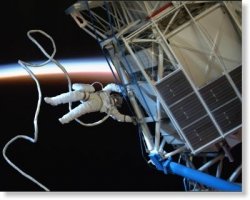
This was the EVA that would set the record of slightly over seven hours. Goals included taking pictures of Comet Kohoutek, doing some repairs of one of the solar telescopes and replacing the film canisters on the ATM. For the photography, Bill Pogue was to set up a special camera while Jerry Carr took care of some of the ATM duties. Pogue couldn’t see the comet but had diagrams from Houston and the setup and photography went smoothly enough to give him some extra time. He spent it crawling around on the more accessible parts of Skylab.
He ended up near the ATM end of Skylab and spent a long moment just enjoying the view. Skylab had developed a problem with one of the gyroscopes. Engineers in Houston had thought that two working gyroscopes should be adequate, but they kept having to make adjustments. He overheard Ed Gibson, who had remained inside, troubleshooting a new problem with Mission Control. The airflow through his suit was actually causing the humongous space station to move, a situation similar to Skylab 2’s Bill Weitz managing to move Skylab with a giant shepherd’s crook. It wouldn’t have happened on Earth’s surface but, in the Newtonian world that astronauts lived in, a Skylabber’s breath was enough to slowly but surely rotate Skylab.

Jerry Carr chose that moment to ask for help with some of his work. Pogue maneuvered his way down and helped him reach a point that Carr couldn’t quite reach on his own. After the EVA, the Capcom informed them of their new record and the Skylabbers made a video in which they showed off a little Christmas tree they had made with food can liners and decorated with a little silver foil star in honor of Comet Kohoutek. It actually looked pretty good for an improvised Christmas tree.
EVA #3
December 29, 1973

The third EVA came only four days after the second. The main aim was to get more pictures of Kohoutek and also to obtain a sample of the Airlock Module’s micrometeoroid cover for testing. Kohoutek was a disappointment. They did get pictures, but the comet was fainter than expected and the film wasn’t really sensitive enough to pick much up. The ground was able to get better pictures and Gibson later made sketches of what he saw, some of which are on display at the Smithsonian Museum in Washington D.C.
More Fun on Skylab 4
ATM Operations and Scientific Observations
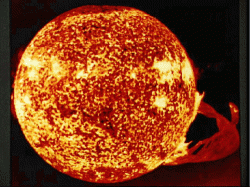
Ed Gibson was Skylab’s resident expert on the ATM and the sun. He had specialized in plasma physics at Caltech and written a textbook on the sun. One of his goals on Skylab was to catch a flare during its “infant” stages, which would help scientists on the ground understand the trigger mechanism for solar flares. He would have only seconds to decide whether a flare was about to start or risk recording an abortive event. He practiced keeping an eye on the extreme ultraviolet (XUV) monitor, which would show active regions about to start boiling. After the scheduling problem was solved, he spent most of his free time at the ATM and was finally able to catch a flare in the very early stages.
The ATM specialists on the ground could also operate the equipment through remote control, leading to one embarrassment for the crew. A solar observatory based in Hawaii caught the start of a large prominence and promptly notified Houston. The crew was asleep, so the ATM people captured pictures that included the one above. Solar physicists obtained a lot of valuable information with the ATM work and Gibson regarded Skylab’s work with solar observations as arguably the best proof that the judgment of astronauts in orbit was essential to space work.
With more free time, the Skylab crew began to invent experiments. Bill Pogue got his crewmates to help him film a demonstration that air was a medium similar to water and it was possible to “swim” through it in weightless conditions. He got some spare cardboard, turned it into fins and found a crash helmet that Carr though made him look like a huge finned bug. He flapped around while his crewmates laughed at him and actually began to move.
Earth observations were always interesting. Gibson enjoyed picking out his hometown of Buffalo, New York, and their observations of southern California led to the discovery of a faultline that ran through the airfield at Palmdale, right where they planned to construct the Space Shuttles. Luckily, the faultline never gave Palmdale or the Space Shuttle program any trouble.
EVA #4
February 3, 1973

Skylab 4’s fourth EVA was also the final one to take place on Skylab. Carr and Gibson were to gather all the materials that were slated to return to Earth, including the final removal of ATM film. It also tested a clothesline-like device for moving equipment. The clothesline reminded Gibson of an earlier incident in which the crew had wiped up a damp wall in the Lower Equipment Bay. They had hung up the towels they used to dry it with and, when they checked later, all the towels were dry but the moisture had drifted back to condense on the exact same wall. As Gibson put it, “We had found another way to keep a Skylab crewman busy.”
It didn’t take Gibson long to realize that he hadn’t completely forgotten what it was like to be in the influence of Earth’s gravity. He was out on the ATM end of Skylab when he happened to look back at Earth. He felt like he was going to fall and tightened his grip on a handhold. It was one thing to know intellectually that Newtonian physics wouldn’t let him fall and quite another to convince his reflexes of that.
The clothesline they were using to move equipment seemed to work well as long as the crewmen held it steady to control oscillations. They left it up, which came close to doing Gibson in. The clothesline got snagged on the umbilical that attached him to Skylab and provided him with air. The umbilical got yanked out of the connection to his suit. Gibson didn’t feel it and he was wearing a back-up oxygen pack for exactly this kind of situation. He quickly noticed the spray of yellow ice from the umbilical and reconnected the hose.
The fourth EVA accomplished all of its goals and the crew came back in after about 5 1/4 hours.
Driving Inside Skylab
Who Says Science Can’t Be Fun?

One of the most fun equipment tests that Skylab 4 conducted was a precursor to the Manned Maneuvering Unit (MMU) called the Astronaut Maneuvering Unit (AMU). They could actually drive it inside Skylab. The crew took turns testing it both with and without EVA suits until it began to run low on propellants. During one of the suited test runs, Carr was handling the unit while Pogue took pictures. Pogue didn’t have his radio unit turned on and Carr ran low on oxygen. Pogue kept pointing at the gauge on his leg and Carr indicated that he wanted to finish. Near the end of his run, Pogue noticed that he was starting to turn red and called a halt to the test by reaching over and pulling off his helmet.
One “leisure” experiment that the engineers had invented was known as the Dynamical Acceleration Reference Trajectory Studies (DARTS). Just like it sounds like, it was basically a game of darts that used Velcro rather than needlepoint tips that the crew could play when they had some free time. At first, the crew would instinctively try to lob the darts the same way they would in Earth gravity. That led to the dart ending up pretty far from the target. Gibson figured out that, if he simply pushed the dart toward the target instead of lobbing, he could be much more accurate.

Some of the life sciences experiments occasionally gave the crew trouble. The indefatigable ergonometer proved to be a challenge in zero G and Gibson’s chief complaints included the straps used to hold him in place. His solution was to improvise a headrest by taping a folded towel to the ceiling and resting his head against it while peddling. Complaints from previous crews included the loss of muscle in their legs. On the ground, SMEAT crew member Bill Thornton improvised a treadmill using a piece of Teflon. Straps could be used to pull the crewman down while he walked or ran on the treadmill. Carr and Pogue found time to poke fun at exercising in zero G, showing off how one might substitute a dummy astronaut for dumbells in orbit.
The limited in-flight food options had frequently been a complaint among astronauts and dietician Rita Rapp developed condiments for Skylab 4 that were pretty luxurious for orbital missions: liquid salt and pepper, hot sauce, horseradish and garlic. On the flip side, the crew had agreed to eat food bars for all their meals every third day. These weren’t modern energy bars, but dry crunchy things that filled the crew’s nutritional needs and not much else. It was, according to Gibson, one of the “supreme sacrifices” they made in the hopes of extending the mission from the slated 56 days to the full 84 days.
The plan worked so well that the idea of extending to 94 days was floated around for a while. It was vetoed on the grounds that they simply couldn’t stretch their food supplies any farther and they began preparations to come back on schedule. Even so, at least one crew member found it tough to leave. Gibson had come to think of Skylab as a kind of orbital home that would have been perfect if they could have gotten a decent pizza delivery and brought their families along.
Skylab 4 Comes Home
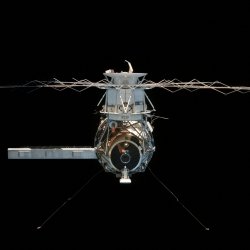
The Skylab 4 crew left with high hopes for the future of the little space station. Work on the Space Shuttle was proceeding and they hoped that it would be finished in time to boost Skylab to a higher orbit. They even left a time capsule with a variety of materials for future Shuttle missions to bring back to Earth for scientists to study. They undocked smoothly and flew around Skylab, taking pictures as they went.
Carr had some trouble maneuvering the Command Module into reentry attitude but was able to bypass the black boxes and apply power directly to the reaction control jets. The crew landed fairly close to their target and were quickly picked up by the USS New Orleans. Once Gibson recovered from the expected amount of wobbliness and returned to land, he tried a five mile run and found out fast that he wasn’t yet back to peak performance. He was happy with the success of the entire Skylab program and was, in fact, disappointed that they couldn’t have used a few of the Saturn rockets developed for Apollo to fly a few Skylab-sized modules up and hook them together to make a bigger space station.
The De-Orbiting of Skylab
11 July 1979
A Few Books About Skylab
If I haven’t bored you out of your skull with more than 15,500 words about Skylab, you might be interested in learning more about the story of Skylab.












